From majestic killer whales and pods of bottlenose dolphins to common minkes and enormous fin whales, Britain’s waters are home to a range of cetacean species.
Learn about Britain's dolphins, porpoise and whales, including identification, the best places to see them and boat excursions with our guide to the UK's most common cetacean species.
Find out more about wildlife found on the British coast with our guides to jellyfish, beachcombing and seabirds.
Britain's dolphin species -what species of dolphins can you see in the UK?
At least seven species of dolphins have been sighted in British waters - the easiest the spot include bottlenose and common dolphins.
Common dolphin, Delphinus delphis
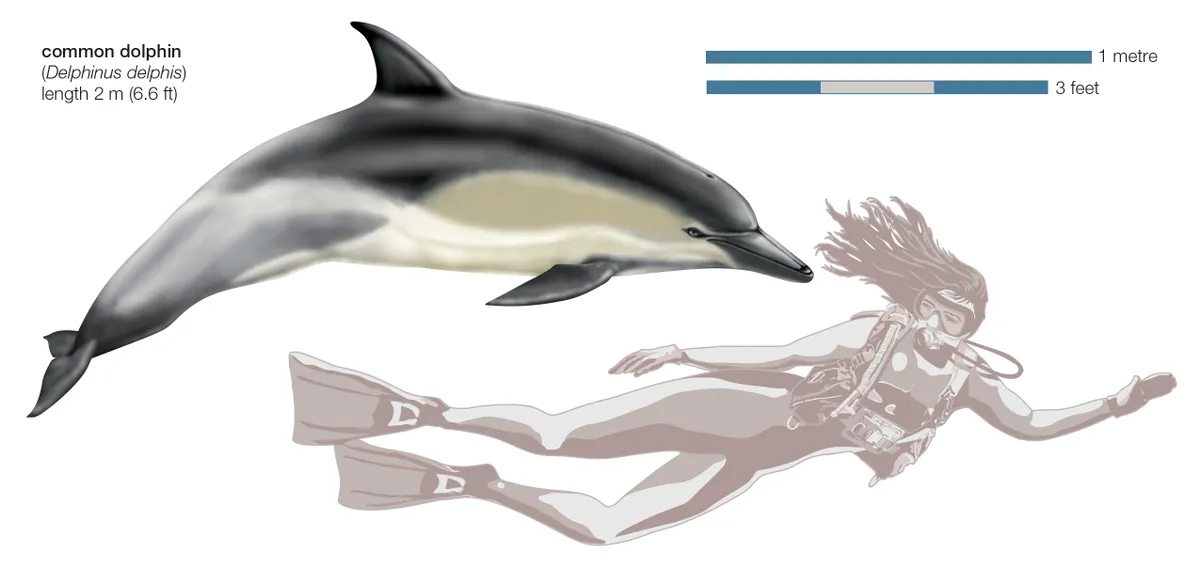
Length: 1.6-2.5 metres
Features/body type: Slim beak and slender body
Fin: Dorsal fin curved and slim
Appearance: Lightly coloured underneath
Distribution: English Channel, south-west and north-west England, west Scotland, Ireland and the Irish Sea
Threats: Fishing gear entanglement, pollution
Interesting fact: These dolphins have a pattern on their sides that looks like an egg-timer
Bottlenose dolphin, Tursiops truncatus

Length: up to 4 metres
Features/body type: Circular head with stubby beak
Fin: Distinctive dorsal fin, located centrally
Appearance: A grey or brown appearance, paler underneath
Distribution: South-west England, west Ireland, Moray Firth and Cardigan Bay
Threats: Habitat degradation
Interesting fact: Bottlenose’s are known for their acrobatic breaches (leaps) out of the water
Risso’s dolphin, Grampus griseus
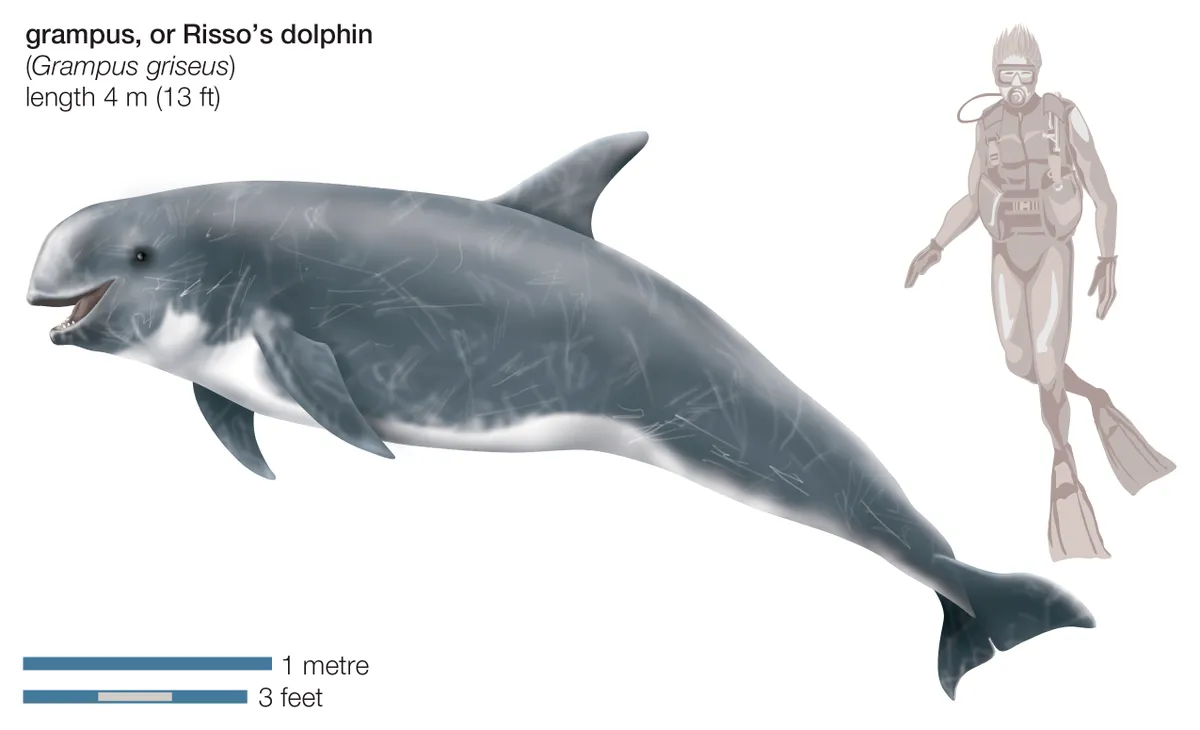
Length: Up to 3.8 metres
Features/body type: Rotund head
Fin: A high, curved dorsal fin, dark grey in colour
Appearance: Light grey, particularly on head, whitening with age, with a pale grey-white belly. Scars visible
Distribution: South-west England, north and west Scotland, west Ireland and Irish Sea
Threats: Marine litter, pollution, acoustic disturbance
Interesting fact: These dolphins have no beak
White-beaked dolphin, Lagenorhynchus albirostris
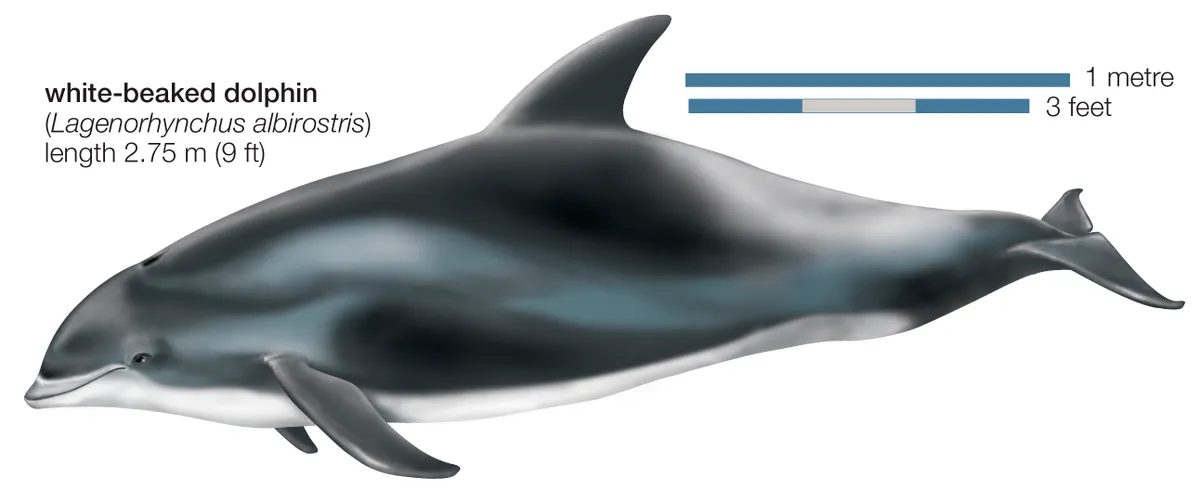
Length: 2.5-2.8 metres
Features/body type: A sturdy dolphin with a stubby beak
Fin: A tall, arched dorsal fin
Appearance: Largely black with white colouring on the end of their back and their sides
Distribution: Scotland, Atlantic coast of Britain and Ireland
Threats: Overfishing and fishing gear-related difficulties
Interesting fact: Local to Britain’s north-west
Killer whale or orca, Orcinus orca
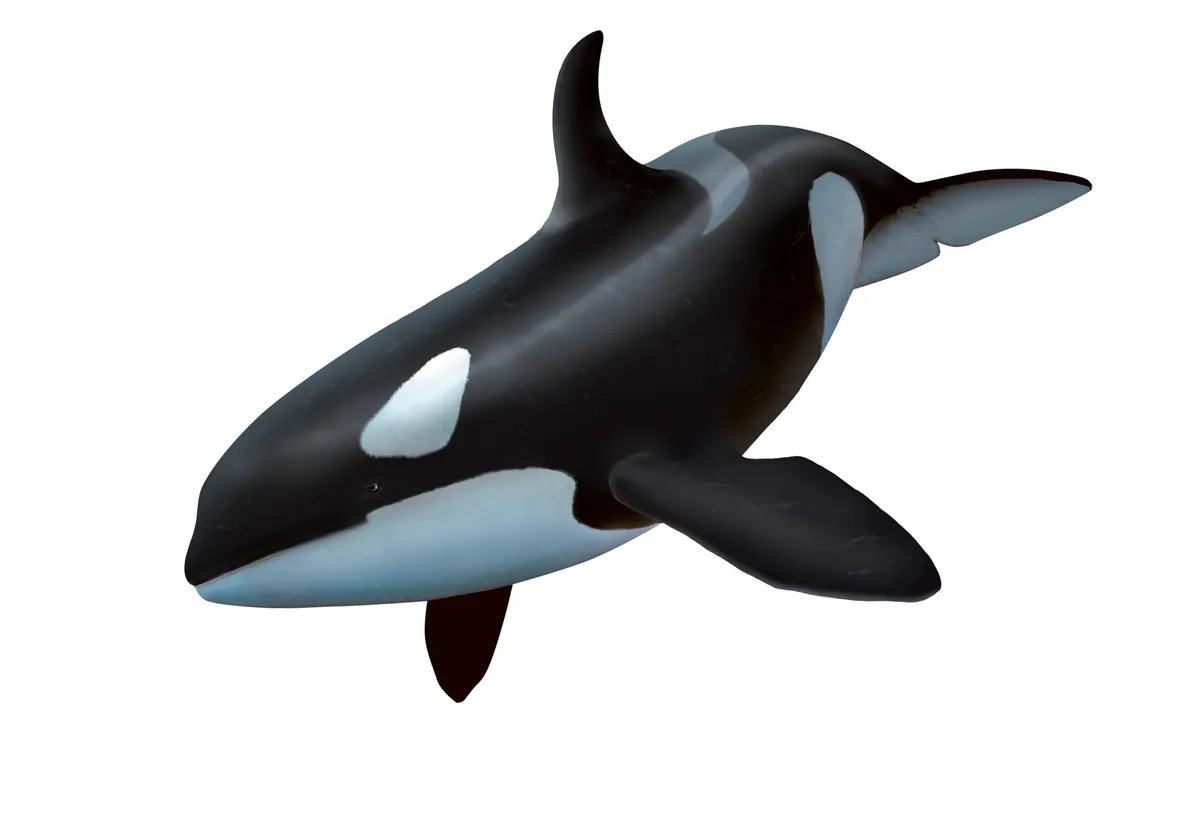
Length: Males can grow up to 9 metres
Features/body type: Very large, can in excess of 6 tonnes
Fin: Tall and black in colour. Males’ fins are particularly tall
Appearance: Black with characteristic white patches behind eyes and fin
Threats: Marine pollution, scarcity of prey and consuming contaminants
Interesting fact: Killer whales are the largest member of the dolphin family
Striped dolphin, Stenella coeruleoalba
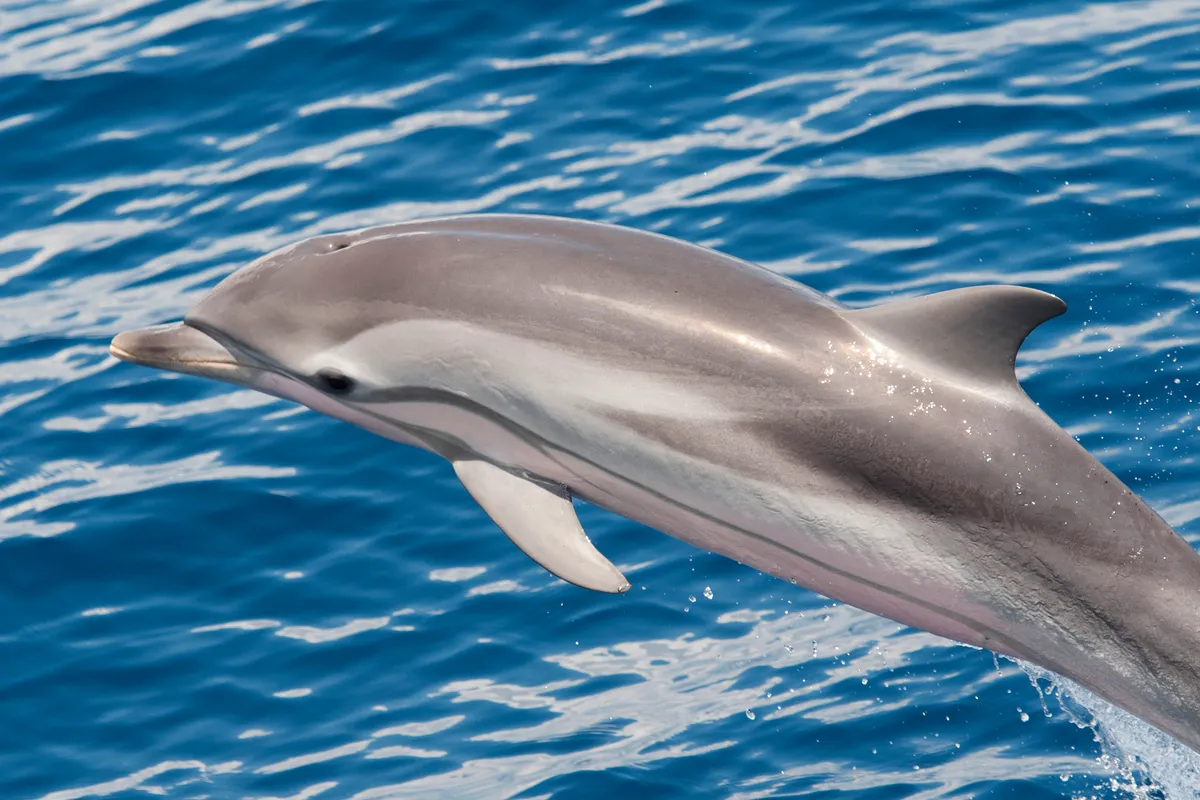
Length: Up to 2.6 metres
Features/body type: Stubby beak
Appearance: most obvious feature is a stripe linking the beak to the the rear of the body
Distribution: Western side of British waters
Interesting fact: they have a gestation period of 10 to 12 months
What colours can dolphins see?
Studies show that dolphins can see in shades of grey, as well as the blue-green spectrum. Dolphins usually stay in shallow water but are capable of diving down to depths of 260 metres. Bottlenose dolphins have bigger brains than humans (1600 grams versus 1300 grams), and a brain-to-body-weight ratio greater than great apes.
What do you call a group of dolphins?
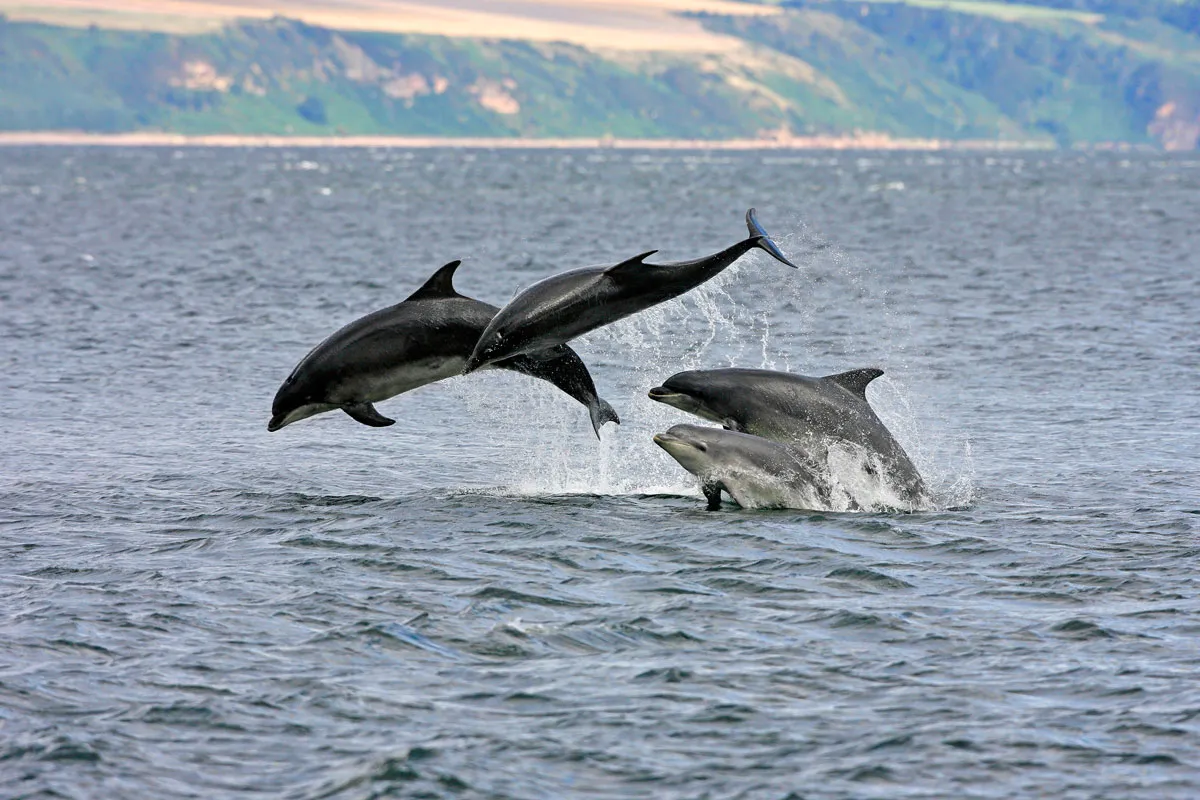
A group of dolphins is known as a pod. Dolphins can communicate with various noises, usually in the form of clicks and whistles.
How do dolphins give birth?
The dolphin is the only mammal that gives birth to its baby tail first. Each dolphin's dorsal fin is totally unique.
Which dolphin species are endangered?
Endangered dolphins like the Maui’s dolphin are on the brink of extinction due to entanglement in fishing gear. All dolphins are threatened by pollution, climate change, and commercial harvest. Pink river dolphins live in the Bolivian Amazon.
Britain's porpoise species
Harbour Porpoise, Phocoena phocoena
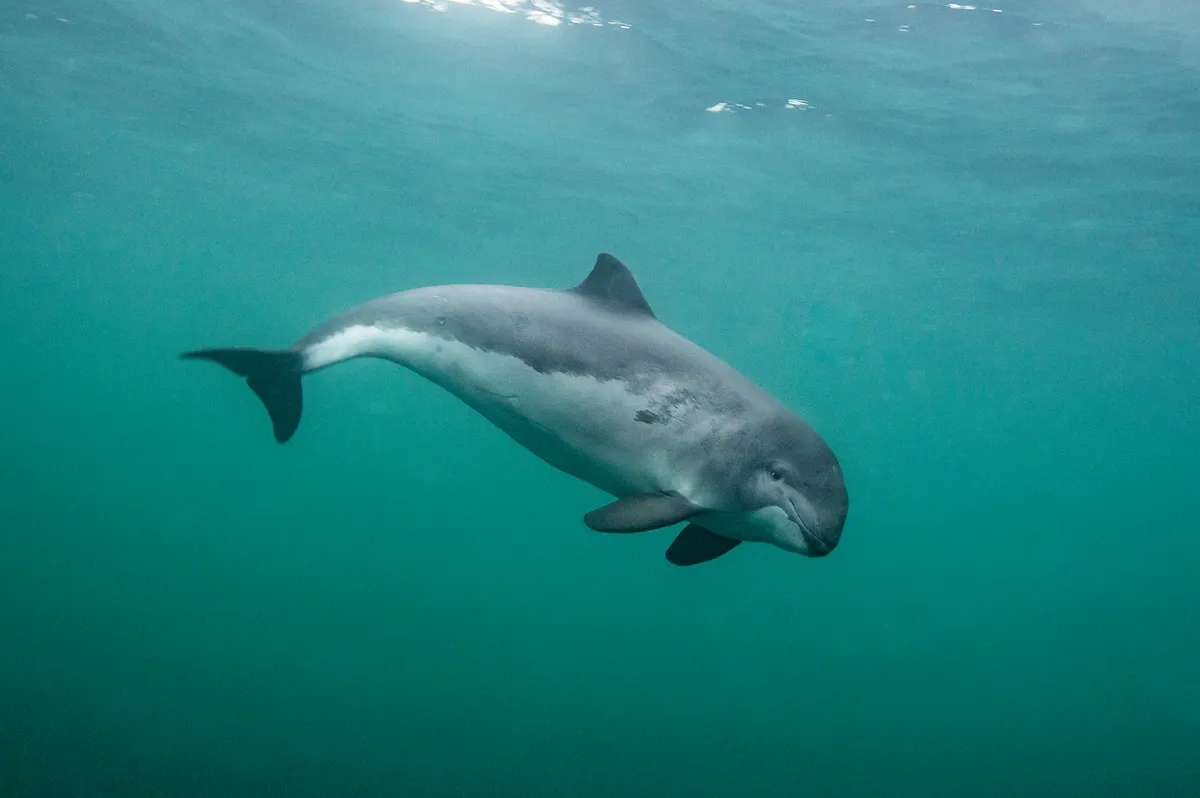
Length: Up to 1.8 metres
Features/body type: A small, rounded head
Fin: Triangular, blunt dorsal fin, located just behind the centre of the back
Appearance: Robust dark body with a pale-grey underside
Threats: Accidental capture in fishing nets
Interesting fact: Harbours are the only member of the porpoise family found in European waters
Britain's whale species
Minke whale, Balaenoptera acutorostrata

Length: 7-9 metres in length
Features/body type: Large body with pointed, triangular head
Dorsal fin found over half-way down their back is arched
Appearance: Flippers marked with white slash
Threats: Accidental collisions with UK ships and overfishing
Interesting fact: Can be seen near the shoreline
Fin whale, Balaenoptera physalus
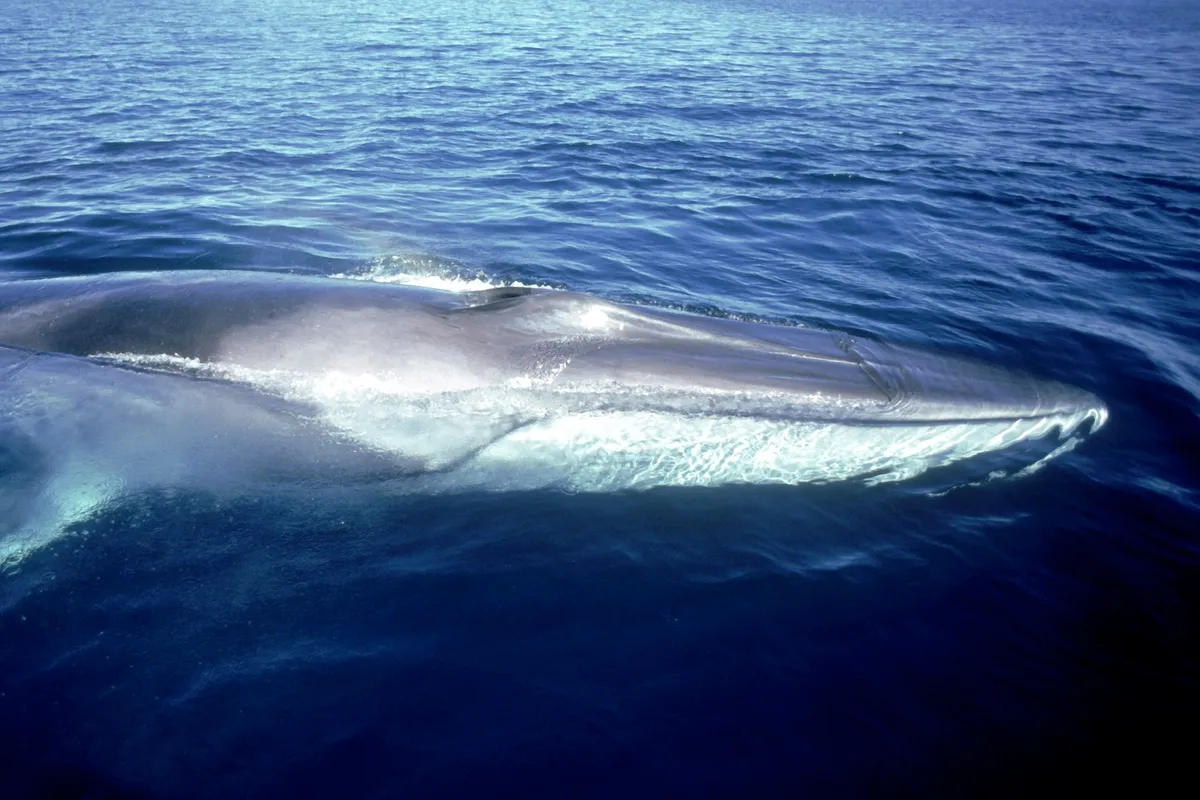
Length: An overwhelming 18-24 metres long
Features/body type: A vast whale with pointy head
Fin: Relative to their body size, their fin is only minute
Appearance: Bottom jaw on the right-hand side is white
Threats: Overfishing and marine pollution
Interesting fact: Fin whale’s blows are up to 6 metres high
Long finned pilot whale, Globicephala melas

Length: 4- 6 metres in length
Features/body type: Lengthy flippers and a rotund head
Fin: Angled towards their rear, this is a low-level fin
Appearance: Black in colour
Threats: Accidental collisions with ships and fish gear difficulties
Interesting fact: pods found in deeper waters
Sperm whale, Physeter macrocephalus
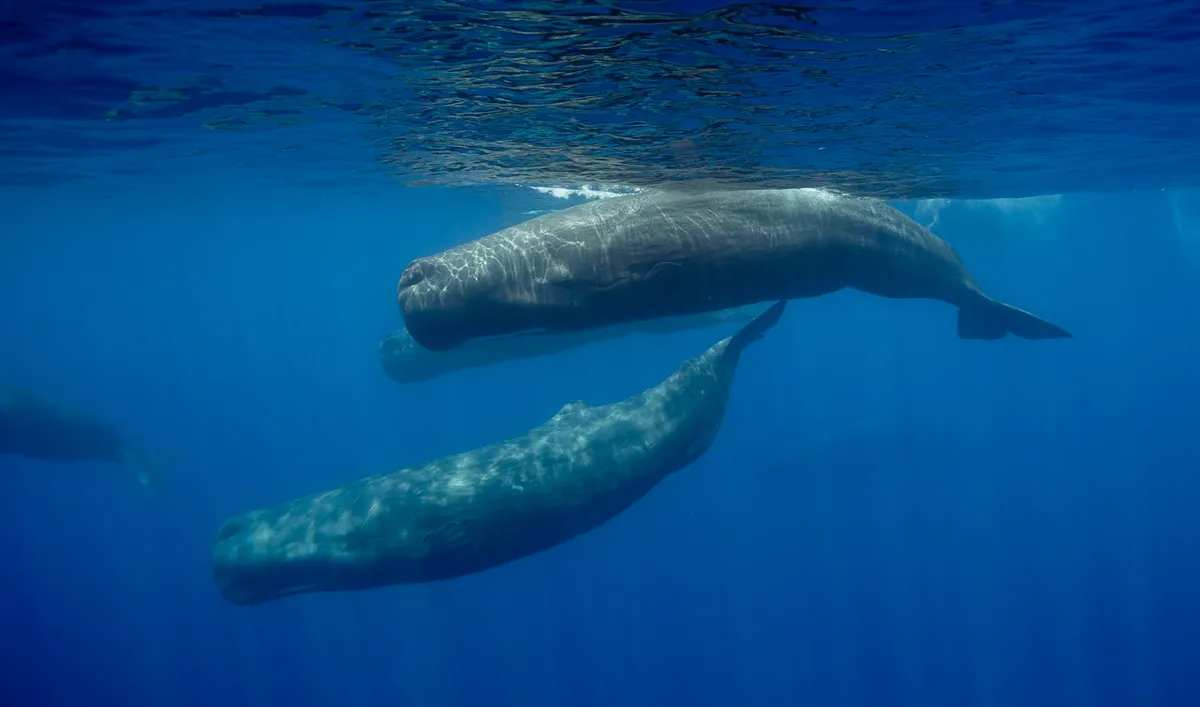
Length: 8 to nearly 16 metres long
Features/body type: Lower jar is only small, relative to a larger square head
Fin: More akin to a pointed hump
Threats: Plastic pollutants, fish gear difficulties, acoustic disturbance
Interesting fact: Sperm whale’s blows can reach 5 metres high
Humpback whale, Megaptera novaeangliae

Length: 11.5- 15 metres long
Features/body type: Sturdy whale, with bumps across bottom jaw and head
Fin: Short dorsal fin over half way along the whale’s back
Appearance: Tail is white underneath with a jagged edge
Threats: Noise pollution, fish gear difficulties, chemical pollutants.
Interesting fact: This whale is known to flipper slap
Northern bottlenose whale, Hyperoodon ampullatus
Length: 7-9 metres long
Features/body type: Sturdy whale with a rotund head and stubby beak
Fin: Dorsal fin is tall and angular
Appearance: Light to dark shades of brown
Threats: Plastic pollution, fish gear difficulties, overfishing and its impact on food supply, acoustic disturbance
Useful fact: These are curious mammals known to happily approach non-moving vessels
Cuvier’s beaked whale, Ziphius cavirostris

Length: 5.1-6.9 metres long
Features/body type: Sturdy whale with a little head
Fin: Pointed to mildly angular dorsal fin
Appearance: Their back is a dark colour; be it brown or grey, with the more mature whales having a paler head
Threats: Acoustic disturbance, plastic pollution, overfishing
Interesting fact: This rare UK visitor enjoys deep, warm waters
Sowerby’s beaked whale, Mesoplodon bidens
Length: Around 5 metres long
Features/body type: Slim body with a little head
Fin: Fin is pointed or slightly angular/hooked
Appearance: Deep grey colour body
Threats: Ship collisions, plastic pollutants
Useful fact: Male sowerbys have two outward pointing teeth on their jaw
Best places in the UK to spot whales and dolphins
From Land’s End in England's far south to the Orkneys off the coast of northern Scotland, here are seven go-to destinations renowned for both on and off-land whale, dolphin and porpoise sightings.
The Islands of Northern Scotland
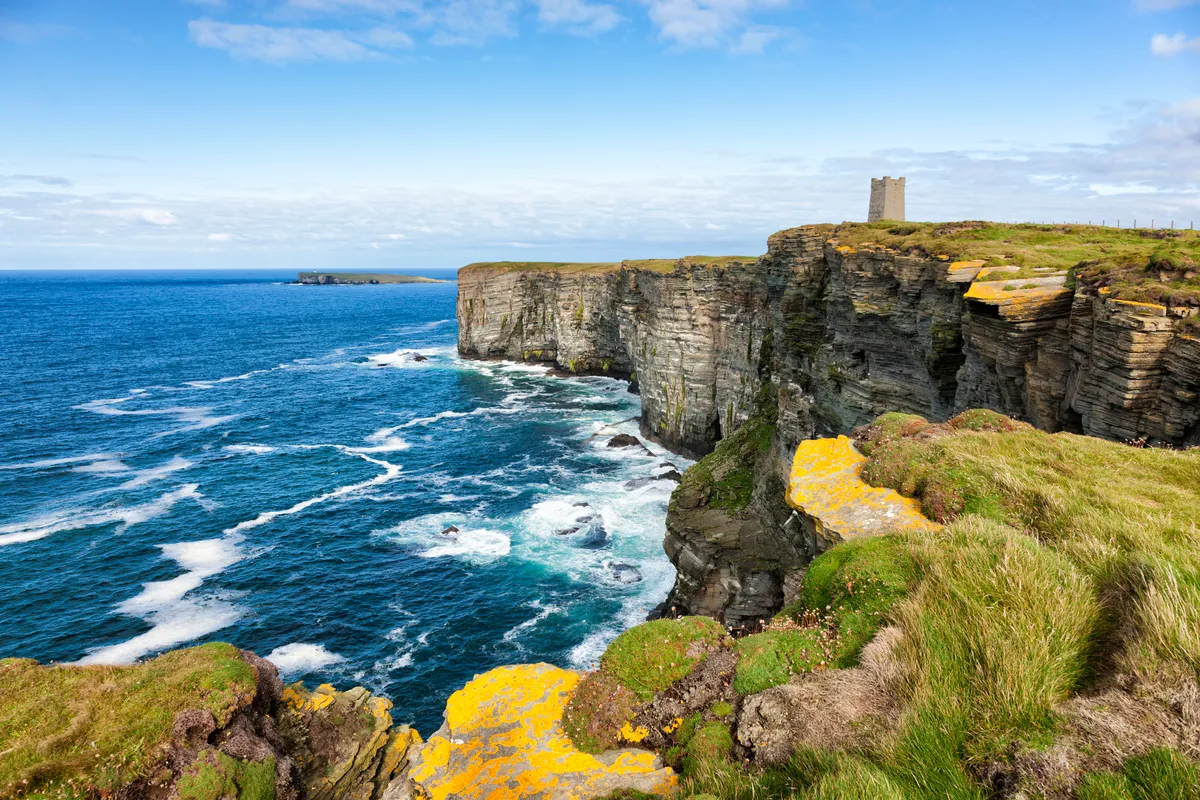
Some of the most spectacular whales and dolphins mentioned in our guide can be found off the coast of Orkney and Shetland. Keep an eye out for risso’s dolphin, minke wales and even awe-inspiring orcas throwing their prey up in the air. Take a NorthLink Ferry from Scotland's mainland to reach Shetland and Orkney's marine mammal hotspots.
Cardigan Bay, Wales
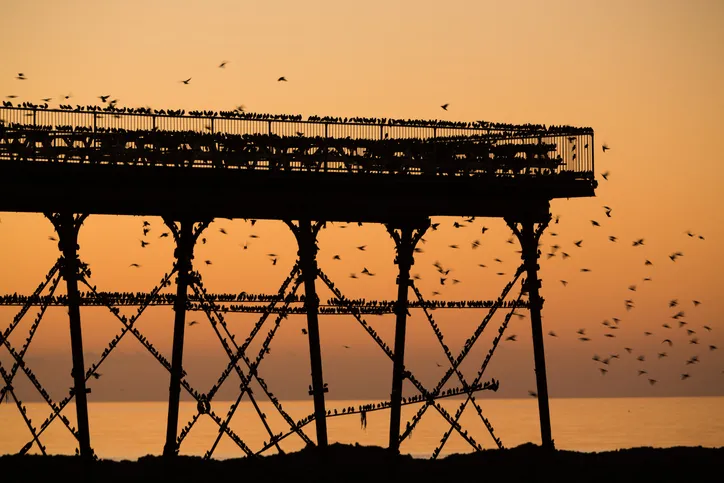
Bottlenose dolphins form one of Cardigan Bay’s so-called ‘big three’, along with harbour porpoises and Atlantic grey seals, and hence this area of Wales is a hotspot for catching a glimpse of these acrobatic mammals. The Wildlife Trust of South and West Wales works closely with Dolphin Survey Boat Trips offering an eco-tourism tour led by experts in the field.
Anglesey, North Wales
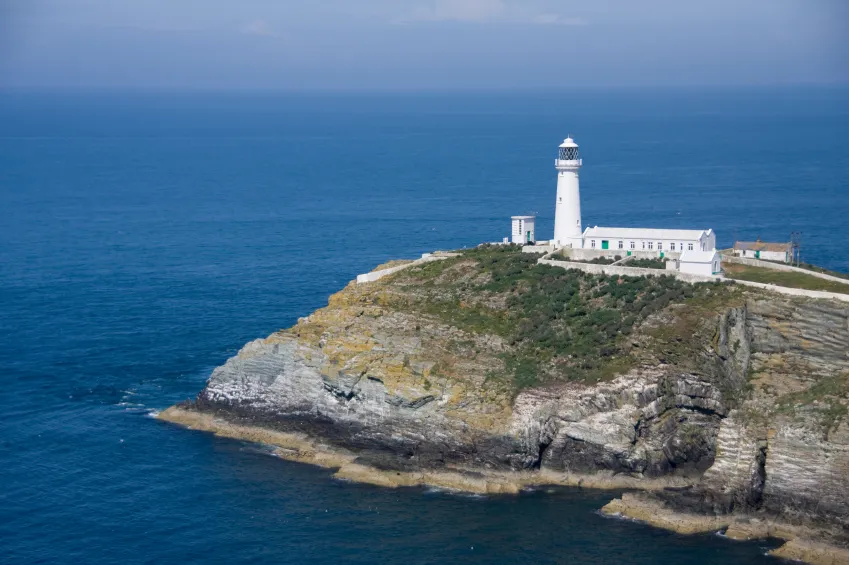
Head to Anglesey’s Point Lynas and Puffin Island for a dolphin watching session. Seacoast Safaris dock at the historic town of Beaumaris in Anglesey and with a range of cruising times.
Land’s End Peninsula and St Ives Bay, Cornwall
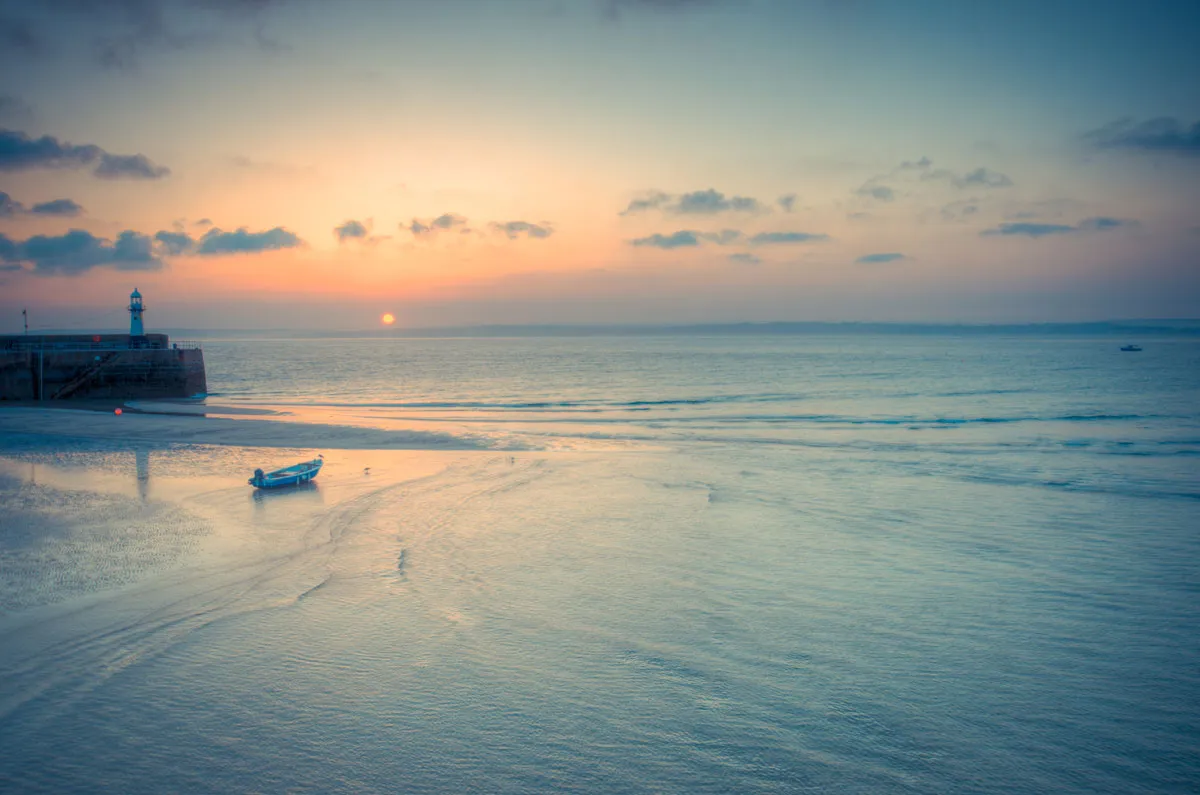
For those after nearshore sightings, The Sea Watch Foundation recommends headlands and bays as the place to be. Hence, it’s no surprise that Cornwall’s Land’s End Peninsula and St Ives Bay are ideal for spotting bottlenoses. In fact, this region boasts England’s only resident population of bottlenose dolphins.
Berry Head and Dartmouth, Devon
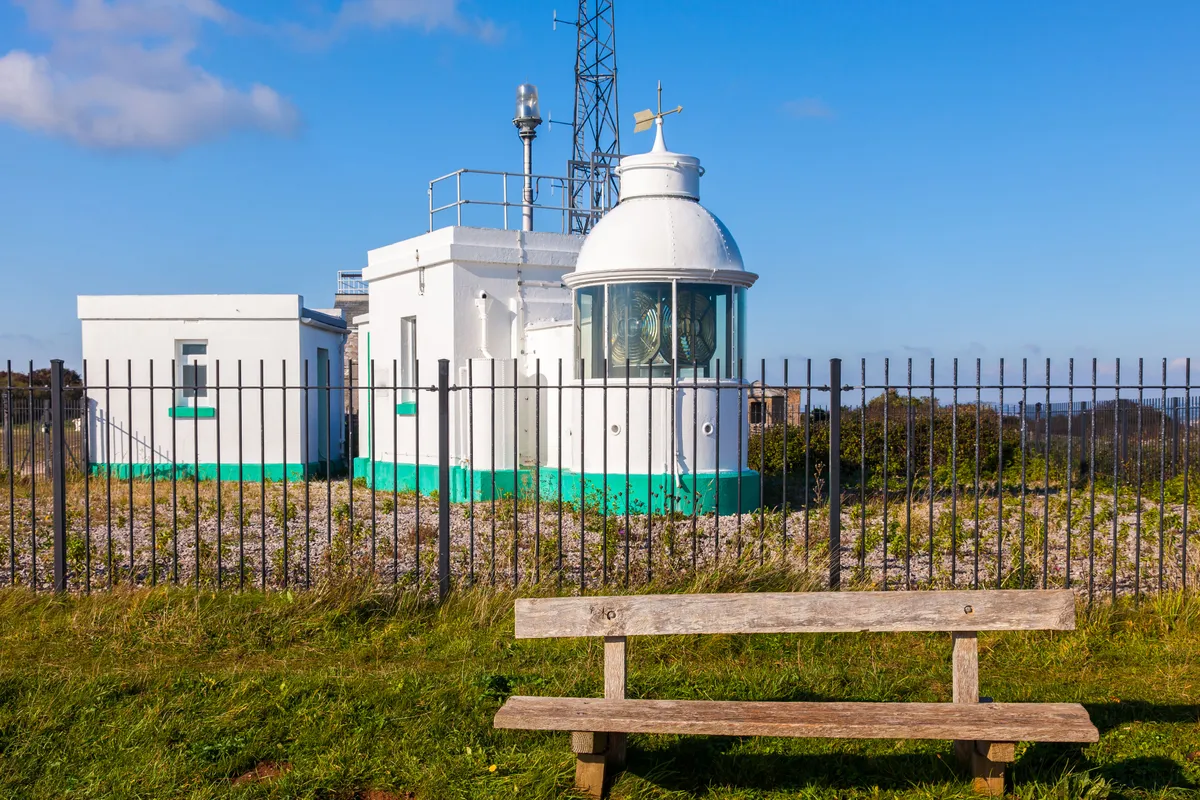
Large groups of common dolphins can be observed from the iconic coastal headland of Berry Head in Devon. For those wishing to be closer to the water, head further south to Dartmouth for a historic, wildlife-enriched tour. The Dartmouth coastal cruise is one hour long and offers the possibility of dolphin sightings.
